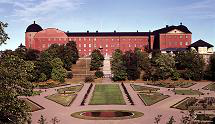Speaker
Dr
Naofumi Kuroda
(University of Tokyo)
Description
The ASACUSA collaboration has been making a path to realize high precision microwave spectroscopy of ground-state hyperfine splitting of antihydrogen atom in flight for a stringent test of the CPT symmetry. For our physics goal, an efficient extraction of a spin polarized antihydrogen beam is essential.
In 2010, we have succeeded in synthesizing our first cold antihydrogen atoms employing a CUSP trap consisting of a superconducting anti-Helmholtz coil and a stack of multiple ring electrodes[1]. This was achieved with our antiproton accumulator, MUSASHI, and a positron accumulator. However the rate of antihydrogen synthesis was limited by a low accumulation efficiency of positrons. In addition, the total number of synthesized antihydrogen was found to be suppressed[1]. To proceed the next step, we made improvements, like for example a modified positron source for rapid experimental cycle and a new mixing scheme to prolong the reaction period.
An antihydrogen beam detector has also been developed. It was comprised of an inorganic single-crystal scintillator and surrounding plastic scintillator plates.
We report the recent results of antihydrogen synthesis and attempts of an anti-atomic beam production.
Ref.[1] Y. Enomoto et al., Phys. Rev. Lett. 105 (2010) 243401.
Primary author
Dr
Naofumi Kuroda
(University of Tokyo)
Co-authors
A. Mohri
(Atomic Physics Laboratory, RIKEN)
B. Radics
(Atomic Physics Laboratory, RIKEN)
B. Wuenschek
(Stefan-Meyer-Institut fuer Subatomare Physik,)
C. Malbrunot
(Stefan-Meyer-Institut fuer Subatomare Physik)
C. Sauerzopf
(Stefan-Meyer-Institut fuer Subatomare Physik)
D.J. Murtagh
(Atomic Physics Laboratory, RIKEN)
E. Lodi Rizzini
(Universita di Brescia & Istituto Nazionale di Fisica Nucleare)
E. Widmann
(Stefan-Meyer-Institut fuer Subatomare Physik)
H. A. Torii
(University of Tokyo)
H. Higaki
(Hiroshima University)
H. Nagahama
(University of Tokyo)
J. Zmeskal
(Stefan-Meyer-Institut fuer Subatomare Physik)
K. Michishio
(Tokyo University of Science)
K. Suzuki
(Stefan-Meyer-Institut fuer Subatomare Physik)
L. Venturelli
(Universita di Brescia & Istituto Nazionale di Fisica Nucleare)
M. Diermaier
(Stefan-Meyer-Institut fuer Subatomare Physik)
M. Leali
(Universita di Brescia & Istituto Nazionale di Fisica Nucleare)
M. Ohtsuka
(University of Tokyo)
M. Tajima
(University of Tokyo)
N. Zurlo
(Universita di Brescia & Istituto Nazionale di Fisica Nucleare)
O. Massiczek
(Stefan-Meyer-Institut fuer Subatomare Physik)
S. Federmann
(Stefan-Meyer-Institut fuer Subatomare Physik and CERN)
S. Sakurai
(Hiroshima University)
S. Ulmer
(Ulmer Initiative Research Unit, RIKEN)
S. Van Gorp
(Atomic Physics Laboratory, RIKEN)
T. Mizutani
(University of Tokyo)
V. Mascagna
(Universita di Brescia & Istituto Nazionale di Fisica Nucleare)
Y. Kanai
(Atomic Physics Laboratory, RIKEN)
Y. Matsuda
(University of Tokyo)
Y. Nagashima
(Tokyo University of Science)
Y. Nagata
(Atomic Physics Laboratory, RIKEN)
Y. Yamazaki
(University of Tokyo and Atomic Physics Laboratory, RIKEN)

